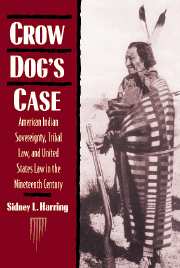 Crow Dog's Case
Crow Dog's Case Book contents
- Frontmatter
- Contents
- Acknowledgments
- 1 “This high pretension of savage sovereignty”
- 2 Corn Tassel: state and federal conflict over tribal sovereignty
- 3 U.S. Indian law and the Indian nations: the Creek Nation, 1870–1900
- 4 Crow Dog's case
- 5 Imposed law and forced assimilation: the legal impact of the Major Crimes Act and the Kagama decision
- 6 Sitting Bull and Clapox: the application of BIA law to Indians outside of the Major Crimes Act
- 7 The struggle for tribal sovereignty in Alaska, 1867–1900
- 8 The legal structuring of violence: U.S. law and the Indian wars
- 9 Conclusion
- Index
6 - Sitting Bull and Clapox: the application of BIA law to Indians outside of the Major Crimes Act
Published online by Cambridge University Press: 23 September 2009
- Frontmatter
- Contents
- Acknowledgments
- 1 “This high pretension of savage sovereignty”
- 2 Corn Tassel: state and federal conflict over tribal sovereignty
- 3 U.S. Indian law and the Indian nations: the Creek Nation, 1870–1900
- 4 Crow Dog's case
- 5 Imposed law and forced assimilation: the legal impact of the Major Crimes Act and the Kagama decision
- 6 Sitting Bull and Clapox: the application of BIA law to Indians outside of the Major Crimes Act
- 7 The struggle for tribal sovereignty in Alaska, 1867–1900
- 8 The legal structuring of violence: U.S. law and the Indian wars
- 9 Conclusion
- Index
Summary
The legal history from Crow Dog to Kagama traces a relatively clear path: the U.S. Supreme Court interpreted federal Indian law to permit Congress to impose federal authority on Native Americans. Lower federal courts were then faced with dozens of individual problems calling for the application of this new law in a wide variety of legally, factually, and culturally complex situations.
This activity in the federal courts, however, documents only one aspect of the imposition of U.S. law on the tribes. Most of the intervention into the daily lives of Indian peoples took place beyond the reach of the Major Crimes Act – indeed, even beyond the reach of U.S. law in general – through the BIA's creation of two extralegal institutions. During the same period that the BIA was attempting to enact the Major Crimes Act, it established the “Indian police” in 1879 and the “courts of Indian offenses” in 1883. These were “police” and “courts” in name only. They could claim no legal status under either U.S. or tribal law. Rather, they were designed to perform important social control functions to force assimilation of the tribes under the authority of the BIA, through its Indian agents.
A major object of the imposition of this bureaucratic law at the reservation level was the destruction of tribal culture, including traditional law. Although the “law for the Indians” language of Indian reforms lay behind at least a part of the Major Crimes Act, the BIA resisted any idea of bringing the tribes under the applicable state and federal laws that governed white and black Americans.
- Type
- Chapter
- Information
- Crow Dog's CaseAmerican Indian Sovereignty, Tribal Law, and United States Law in the Nineteenth Century, pp. 175 - 206Publisher: Cambridge University PressPrint publication year: 1994


